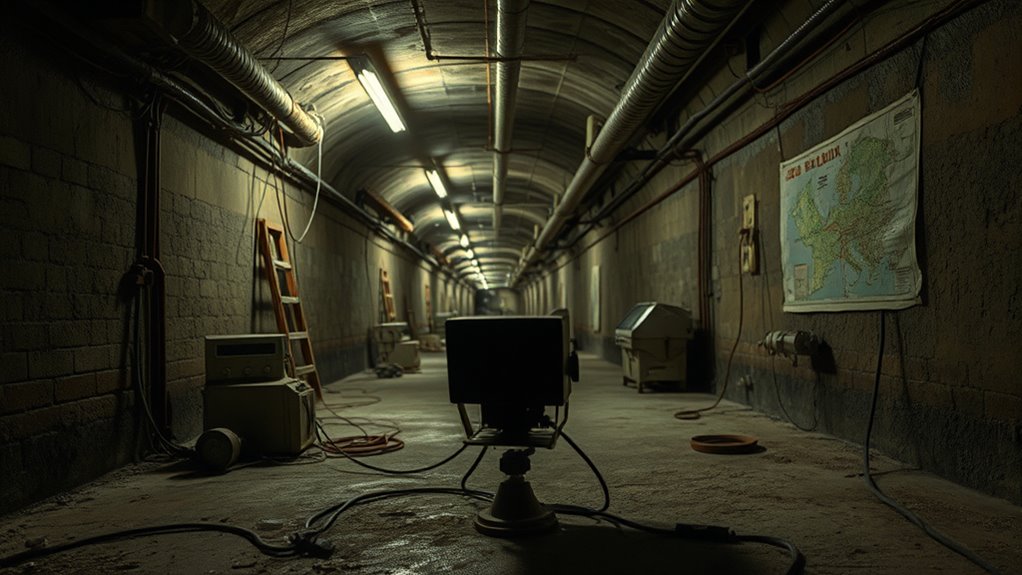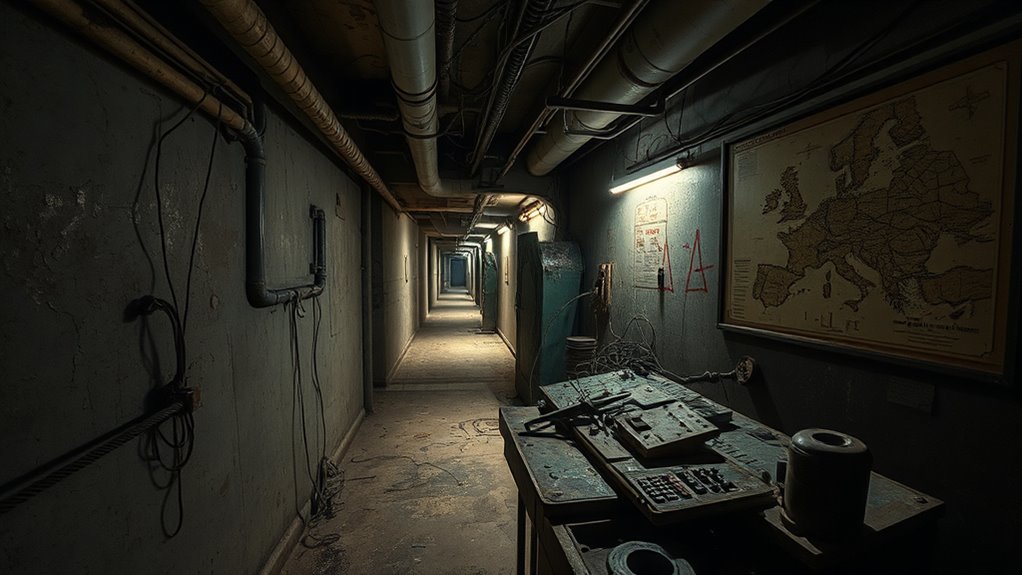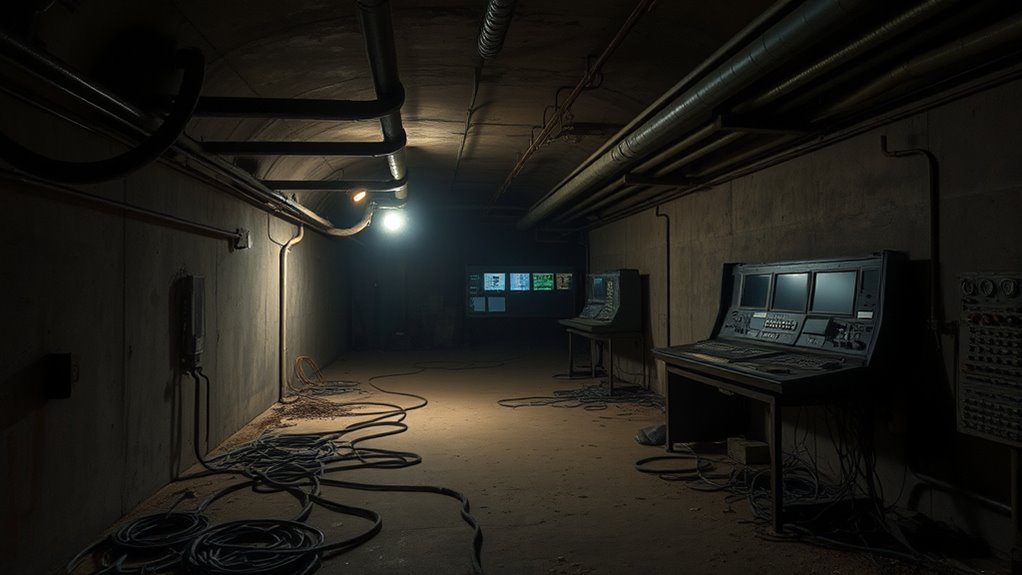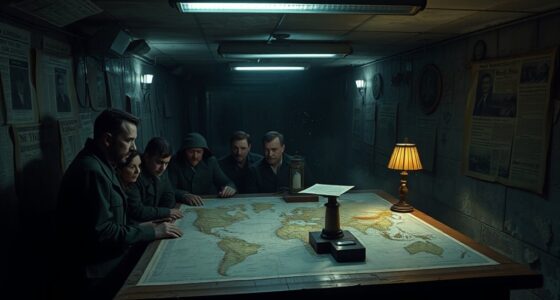The Berlin Tunnel project illustrates early Cold War tech that set the stage for today's intelligence operations. Launched in 1954, its advanced engineering methods helped intercept Soviet communications and shaped military strategies. Personnel played a vital role, analyzing vast amounts of data from nearly 50,000 reels of intercepted messages. The project's adaptability and innovation highlight resource efficiency in espionage, hinting at themes relevant to modern AI applications. Discover more about its enduring impact and lessons learned.
Key Takeaways
- Operation Gold's innovative tunneling techniques demonstrated early applications of covert technology in intelligence gathering, foreshadowing AI's role in data analysis.
- Advanced engineering methods in the Berlin Tunnel project laid groundwork for automated systems in espionage and surveillance operations.
- The massive data collection from Soviet communications during Operation Gold parallels contemporary AI's ability to process and analyze large datasets.
- The meticulous transcribing and analysis of intercepted communications reflect the foundational principles of machine learning in recognizing patterns and extracting insights.
- Lessons from the Berlin Tunnel emphasize the importance of adaptability and resource optimization, key elements in developing AI operational strategies.
The Genesis of the Berlin Tunnel Project

When the Cold War intensified in the early 1950s, the CIA and British MI-6 saw an urgent need to gather intelligence on Soviet military communications in Berlin.
In 1954, they launched the Berlin Tunnel project, codenamed Operation Gold. This ambitious operation aimed to intercept crucial Soviet communications by digging a 1,476-foot-long tunnel connecting the American and Soviet sectors of the city.
To guarantee secrecy, they constructed a structure resembling a Quartermaster warehouse to conceal the tunnel's entrance. However, maneuvering the sandy soil of East Berlin posed significant challenges, requiring specialized equipment and techniques.
To maintain secrecy, a false warehouse concealed the tunnel entrance, while navigating East Berlin's sandy soil proved challenging.
CIA Director Allen Dulles approved the project, recognizing its strategic importance during a period of heightened tensions. You can imagine the stakes involved in this covert endeavor.
Technical Innovations in Espionage

As the Cold War escalated, the need for innovative espionage techniques became paramount, and the Berlin Tunnel project exemplified this evolution in intelligence-gathering methods.
The tunnel's advanced engineering, featuring specialized shields and steel liners, guaranteed it remained structurally sound while secretive. With a diameter of 78 inches and stretching 1,476 feet, it strategically tapped into Soviet communication lines.
Above ground, a warehouse hid the tunnel's entrance, cleverly disguised as a radar station, showcasing the art of misdirection in espionage.
The project also highlighted the shift in intelligence operations, with the Signal Corps 9539th Technical Service Unit paving the way for the Army Security Agency.
Testing a duplicate tunnel in New Mexico further refined operational methodologies, integrating technical innovations into high-stakes environments.
The Role of Intelligence Personnel

The effectiveness of the Berlin Tunnel operation hinged on the expertise and dedication of the intelligence personnel involved. Intelligence officers from the CIA, including Cpl. Eugene Kregg, played an essential role in analyzing intercepted communications. Kregg, a talented linguist, translated critical information that helped shape operations against Soviet intelligence.
The five-person processing unit worked tirelessly, scanning circuits and ensuring effective communication interception. Most analysts were civilians who meticulously transcribed the vast volumes of data collected from the tunnel.
Frank Rowlett enhanced the project's capabilities with his intelligence expertise, while Bill Harvey, an experienced former FBI agent, oversaw the operation as chief of station. Together, these individuals formed a skilled team dedicated to maximizing the operation's success.
Impact and Outcomes of Operation Gold

Although lacking long-term security, Operation Gold had a profound impact on intelligence gathering during the Cold War. This ambitious operation yielded nearly 50,000 six-hour reels of recorded Soviet military communications, enhancing your understanding of their activities.
With around 30,000 reels fully transcribed, you gained 1,750 intelligence reports that provided critical insights into Soviet and East German military capabilities. By monitoring over 500 connections and 121 voice circuits, you accumulated roughly 40,000 hours of phone conversations.
Unfortunately, the discovery of the tunnel by East German workers in April 1956 led to its abrupt cessation. Nonetheless, the intelligence gathered during Operation Gold considerably shaped American and British military strategies, showcasing the lengths taken for effective espionage during this tense period.
Lessons From Cold War Espionage Tactics

Operation Gold illustrates the intricate strategies employed during the Cold War, emphasizing the need for adaptability and innovation in espionage.
In Berlin, the meticulous planning and execution of this operation showcased how military intelligence could leverage both human and technical resources effectively. You can learn a lot from the covert tunneling techniques and advanced engineering methods used. These strategies not only improved communication interception but also set a precedent for future surveillance tactics. Furthermore, the principles of comparative advantage in resource allocation significantly influenced the effectiveness of these operations.
However, the discovery of the tunnel by East German workers serves as a stark reminder of the inherent risks in espionage. It highlights the essential role of counterintelligence measures in protecting operations from exposure and ensuring the success of military intelligence efforts.
Frequently Asked Questions
What Was the Berlin Tunnel Operation?
The Berlin Tunnel Operation was a covert initiative by the CIA and British MI-6 aimed at intercepting Soviet communications in Berlin during the Cold War.
You'd find it fascinating that they constructed a 1,476-foot tunnel to tap into Soviet military cables. Completed in 1955, this operation allowed them to monitor hundreds of connections and gather vast amounts of intelligence before being discovered in 1956 due to heavy rainfall and prior warnings from a double agent.
Why Did the KGB Not Reveal the Existence of the Tunnel to the Russian Military?
Imagine a chess game where the pieces are hidden from each other.
The KGB didn't reveal the tunnel to the Russian military because they wanted to maintain the illusion of invulnerability in their communications.
They believed their systems were secure, even with CIA surveillance.
How Did the Soviets Learn About the Tunnel?
The Soviets learned about the tunnel when heavy rainfall flooded it in April 1956, exposing wires that a maintenance crew discovered.
Despite being warned by double agent George Blake about the tunnel's plans, they initially believed their communications were secure.
The unexpected flooding forced them to confront the reality of the operation, leading to a significant loss of intelligence capabilities for the CIA and marking the end of a vital surveillance effort.
What Was the Method of Operation GOLD?
Imagine sneaking beneath the surface, where whispers of secrets travel through tangled wires.
Operation Gold's method was a masterclass in stealth—CIA and MI-6 joined forces to dig a tunnel right under Soviet noses.
You'd see engineers working tirelessly, crafting a hidden passage to intercept vital communications. Disguised as a radar station, the operation connected American and Soviet sectors, allowing you to listen in on over 500 conversations before nature intervened and revealed the truth.
Conclusion
In reflecting on the Berlin Tunnel Project, it's clear that Cold War espionage was more than just a game of cat and mouse; it was a demonstration of human ingenuity. You can see how those early innovations paved the way for today's AI operations. As we navigate the complexities of modern intelligence, remember the lessons learned from Operation Gold—sometimes, the best strategies lie in the shadows, waiting to be unearthed by those daring enough to dig deep.









